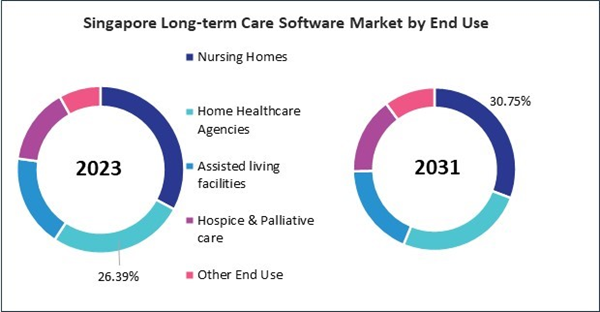The Asia Pacific Long-term Care Software Market is expected to witness market growth of 8.7% CAGR during the forecast period (2024-2031).
The China market dominated the Asia Pacific Long-term Care Software Market by country in 2023, and is expected to continue to be a dominant market till 2031; thereby, achieving a market value of $529.3 million by 2031. The Japan market is registering a CAGR of 8.1% during 2024-2031. Additionally, the India market is expected to showcase a CAGR of 9.5% during 2024-2031.
Several factors, including the growing aging population, the increasing prevalence of chronic diseases, and the need for improved care quality and operational efficiency, have driven the adoption of this software. The increase in the elderly population has led to a higher demand for long-term care services. This demographic shift necessitates adopting advanced software solutions to manage the growing number of residents and their complex healthcare needs.
This software streamlines administrative tasks, reduces paperwork, and automates routine processes. This efficiency allows caregivers to focus more on patient care, improving the overall service quality. By providing real-time access to patient data, facilitating better communication among care teams, and enabling personalized care plans, this software enhances the quality of care delivered to residents.
China’s rapidly aging population is a key driver for the growth of this Market. With 18.7% of the population now aged 60 or older, the demand for long-term care services is increasing at an unprecedented rate. As the number of elderly individuals, especially those aged 65 and above, continues to rise, the need for efficient care solutions becomes more critical. This software will play a central role in managing the healthcare needs of this expanding demographic, offering solutions to streamline patient monitoring, care coordination, and facility management. Thus, both China’s aging populations coupled with the expansion of digital health technologies like telemedicine and diagnostics in India are driving significant growth in the long-term care software market.
The China market dominated the Asia Pacific Long-term Care Software Market by country in 2023, and is expected to continue to be a dominant market till 2031; thereby, achieving a market value of $529.3 million by 2031. The Japan market is registering a CAGR of 8.1% during 2024-2031. Additionally, the India market is expected to showcase a CAGR of 9.5% during 2024-2031.
Several factors, including the growing aging population, the increasing prevalence of chronic diseases, and the need for improved care quality and operational efficiency, have driven the adoption of this software. The increase in the elderly population has led to a higher demand for long-term care services. This demographic shift necessitates adopting advanced software solutions to manage the growing number of residents and their complex healthcare needs.
This software streamlines administrative tasks, reduces paperwork, and automates routine processes. This efficiency allows caregivers to focus more on patient care, improving the overall service quality. By providing real-time access to patient data, facilitating better communication among care teams, and enabling personalized care plans, this software enhances the quality of care delivered to residents.
China’s rapidly aging population is a key driver for the growth of this Market. With 18.7% of the population now aged 60 or older, the demand for long-term care services is increasing at an unprecedented rate. As the number of elderly individuals, especially those aged 65 and above, continues to rise, the need for efficient care solutions becomes more critical. This software will play a central role in managing the healthcare needs of this expanding demographic, offering solutions to streamline patient monitoring, care coordination, and facility management. Thus, both China’s aging populations coupled with the expansion of digital health technologies like telemedicine and diagnostics in India are driving significant growth in the long-term care software market.
List of Key Companies Profiled
- Veradigm LLC
- Oracle Corporation
- MatrixCare (ResMed Inc.)
- Yardi Systems, Inc.
- PointClickCare
- Medtelligent, Inc.
- ALAdvantage, LLC
- Netsmart Technologies, Inc.
- Kareo, Inc.
- Caresmartz, Inc.
Market Report Segmentation
By Mode of Delivery
- Cloud Based
- On Premise
- Web Based
By Application
- Electronic Health Records (EHR)
- Staff Management
- Revenue Cycle Management (RCM)
- Resident Care
- Electronic Medication Administration Record (eMAR)
- Other Application
By End Use
- Nursing Homes
- Home Healthcare Agencies
- Assisted living facilities
- Hospice & Palliative care
- Other End Use
By Country
- China
- Japan
- India
- South Korea
- Singapore
- Malaysia
- Rest of Asia Pacific
Table of Contents
Chapter 1. Market Scope & Methodology
Chapter 2. Market at a Glance
Chapter 3. Market Overview
Chapter 4. Competition Analysis - Global
Chapter 5. Asia Pacific Long-term Care Software Market by Mode of Delivery
Chapter 6. Asia Pacific Long-term Care Software Market by Application
Chapter 7. Asia Pacific Long-term Care Software Market by End Use
Chapter 8. Asia Pacific Long-term Care Software Market by Country
Chapter 9. Company Profiles
Companies Mentioned
Some of the leading companies profiled in this Asia-Pacific Long-term Care Software Market report include:- Veradigm LLC
- Oracle Corporation
- MatrixCare (ResMed Inc.)
- Yardi Systems, Inc.
- PointClickCare
- Medtelligent, Inc.
- ALAdvantage, LLC
- Netsmart Technologies, Inc.
- Kareo, Inc.
- Caresmartz, Inc.
Methodology

LOADING...









